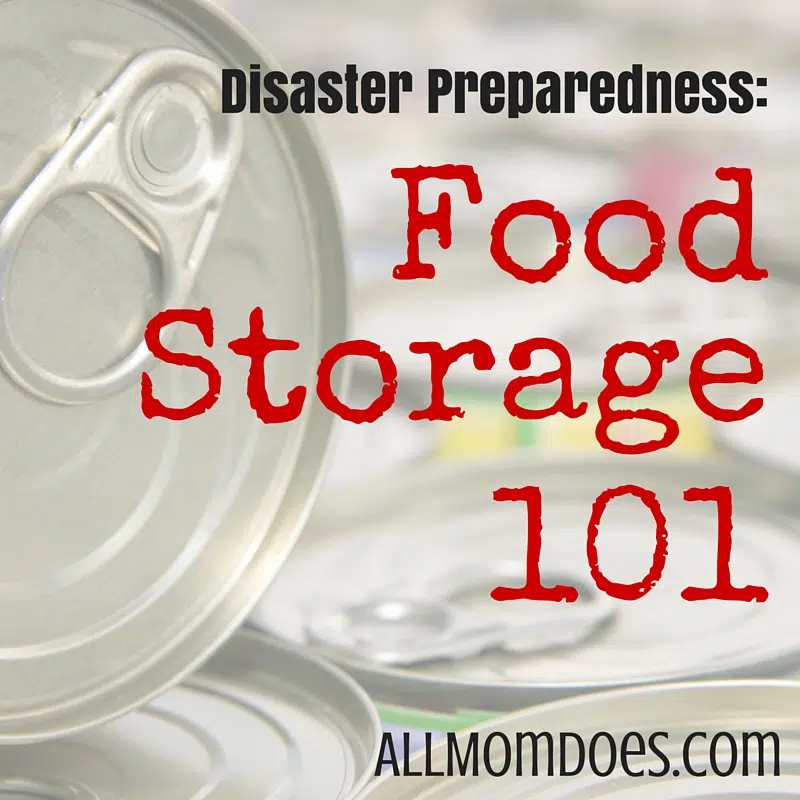Sarah Anne Carter is a contributing writer for The Survival Mom. This is the second in a series of articles on disaster preparedness for AllMomDoes; read her first post on Disaster Prep 101!
The basics of being prepared can come down to the two things we can’t live without – food and water. Creating a food storage can be an important first step and while it may seem overwhelming when you read about having three to six months of food on hand, it can easily be done by taking baby steps. Most of us do grocery shopping for a week or more at a time and the steps to creating a food storage follow those steps.
Make a plan
Pick one meal that your family likes to eat for dinner and make a list of those ingredients. When you can fit them in the budget, buy them and set them aside somewhere in your home. Repeat the same for a lunch meal and then a breakfast meal. You now have one day extra of food storage! You can keep repeating this until you have a week’s worth of food storage. I would recommend having a variety of meals for a week’s menu and then repeating that week to create a month’s supply. Most of us wouldn’t want to eat spaghetti every night for a month. Keep in mind when creating a food storage menu plan to pick meals that you and your family eats. It’s great to find things like tuna on sale, but if your family doesn’t eat tuna, it may not go over well during an extended power outage.
Budget wisely
Unless there is an impending emergency, you can take some time to build up a food storage. Don’t blow your budget buying pre-packaged meals. (Not that you shouldn’t buy them, but if you do, check out reviews and make sure it’s food your family will eat.) If you create a master list, you can look for sales at stores and stock up that way. The Survival Mom has a list of what is usually on sale every month and that can help you plan on what to buy when and save money doing it. Here’s a link to September deals. Another way to keep costs down is to buy dehydrated food, which can easily be incorporated into daily meals and has a long shelf life. Thrive Life is one company that offers a way to stock up and make money doing it.
Stay organized
Food storage requires staying organized so that the food you stock up on doesn’t go to waste. Everyone has a different style, but you’ll want to find some organization system to keep track of what you have and when it expires. You can use a notebook, planner, Excel spreadsheet or an App like Prep & Pantry. I use the app because I almost always have my phone on me and it lets me scan items to add them to my database. I can then email a spreadsheet to myself that I can print out so I can have a hard copy on hand.
Water
Water is very important! You can start stocking up on water by buying a case of bottled water every time you go grocery shopping. Each person in your family needs 1 gallon per day, according to the Red Cross. Water is needed for hydration, cooking, cleaning and bathing. Having containers on hand to fill with water is another way to plan for water storage. A long power outage will eventually affect water supplies. Some people also store water in drums, and that will require adding a purifying agent. Ready.gov has an in-depth article on water storage at www.ready.gov/water. Another way to be prepared in the water department is to have a purifying gadget, like the Life Straw. Having one for everyone in the family can let you use sources of water that might otherwise make you sick.
I’m not an expert by any means – I’m on this journey with you. Our food storage was built up a can at a time and water was stored bottle by bottle. It can be easy to become overwhelmed, but if you break it down into small, easy and affordable steps, you can build confidence and peace of mind as you go along. Remember, being prepared is not about worrying, it’s about facing the future with confidence. The next article in the series will cover other supplies to have on hand, followed by evacuation and worst-case scenarios. If you have any specific questions or topics you want covered, leave me a message in the comments below.
One book that is a great resource if you want more detailed information on being prepared is Survival Mom by Lisa Bedford.
This article contains affiliate links along with links to more in-depth articles on topics found at The Survival Mom.

















